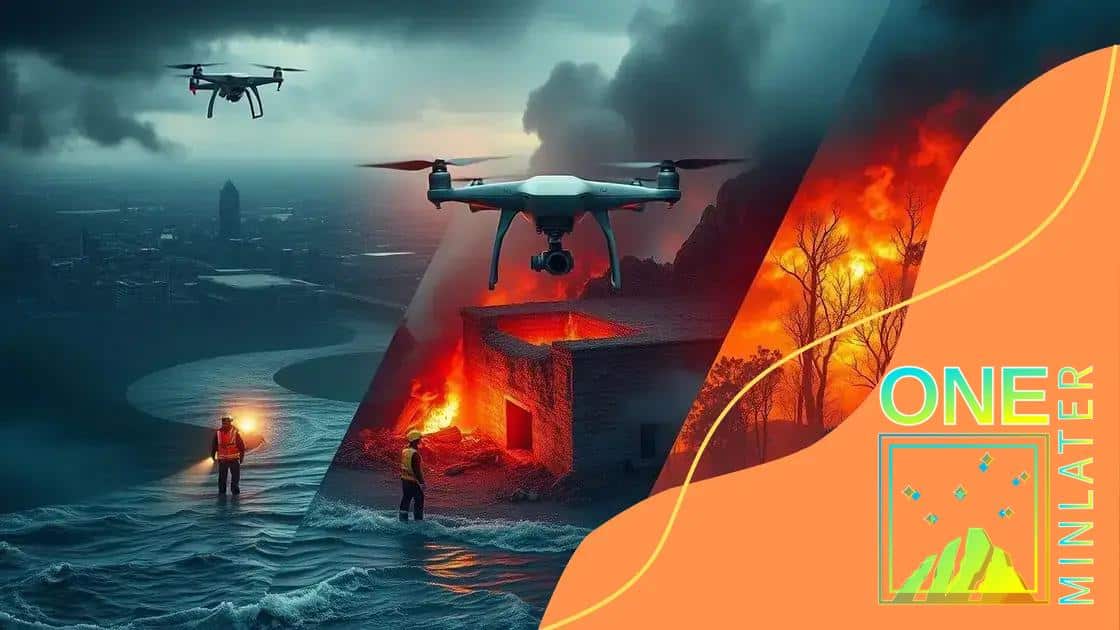The role of drones in emergency disaster relief efforts

The role of drones in emergency disaster relief efforts is crucial as they provide real-time data, deliver essential supplies, and assist in locating victims quickly, improving overall response effectiveness.
The role of drones in emergency disaster relief efforts is transforming how aid is delivered during crises. Have you ever wondered how they enhance rescue missions? Let’s dive into their impact.
Introduction to the significance of drones
Understanding the significance of drones is essential as they become vital tools in various fields. Drones have revolutionized how we approach tasks, especially in emergency situations. Their ability to access hard-to-reach areas makes them indispensable in today’s world.
Impact on Disaster Relief
Drones play a critical role when disaster strikes. They provide real-time data that helps responders make informed decisions quickly. This technology can locate victims, assess damage, and deliver necessary supplies.
- Quick assessment of affected areas
- Screening for survivors
- Supplying medical aid and food
- Mapping out evacuation routes
Moreover, the advantages of using drones extend beyond the immediate response. They can monitor environmental conditions, helping responders adapt to changing situations. This kind of agility is vital for ensuring that help reaches those in need as fast as possible.
Enhancing Communication
Drones facilitate better communication between responders and organizations. By transmitting live video feeds and data, they improve coordination during relief efforts. With clearer information, every party involved can align their resources more effectively.
As we explore the effective use of drones, it’s clear that their ability to gather and relay information can save lives. These devices are not just tools; they represent a shift toward more efficient disaster management.
Types of drones used in disaster relief
There are various types of drones used in disaster relief, each designed for specific tasks and environments. Understanding these different drones is crucial for effective operation during emergencies. Knowing which type to deploy can greatly enhance the relief efforts.
Fixed-Wing Drones
Fixed-wing drones have a traditional airplane shape. They are known for covering large areas quickly, which is valuable when you need to survey a vast disaster zone. With their extended flight times, they can gather critical data efficiently.
- Ideal for mapping large areas
- Longer flight duration
- Utilized for aerial imaging and surveying
Though they require more space for takeoff and landing, their ability to fly long distances makes them advantageous in many situations.
Multi-Rotor Drones
Multi-rotor drones, such as quadcopters, are versatile and popular in disaster relief. They can hover in place and easily maneuver in tight spaces. This flexibility allows them to capture real-time images and videos crucial for assessing damage.
- Can fly in confined spaces
- Real-time video streaming capabilities
- Suitable for delivery of small supplies
Their maneuverability makes them ideal for search and rescue missions where precision is essential.
Additionally, hybrid drones combine the benefits of both fixed-wing and multi-rotor designs. These drones are increasingly gaining traction in disaster relief due to their improved endurance and versatility, making them capable of performing a wider range of tasks.
In summary, each type of drone brings unique capabilities to disaster situations. Whether it is to assess damage, locate victims, or deliver supplies, these advanced technologies significantly enhance the efficiency and effectiveness of response efforts.
Case studies of successful drone deployments

Examining case studies of successful drone deployments reveals how these technologies have changed disaster relief. Numerous real-world examples showcase the versatility and effectiveness of drones in different scenarios.
Hurricane Harvey, USA
During Hurricane Harvey in 2017, drones were deployed to assess damage in Texas. They provided detailed aerial images, helping emergency teams identify the hardest-hit areas quickly. With this information, responders could allocate resources more effectively.
- Real-time data collection enhanced response efforts.
- Drones helped locate people trapped in flooded homes.
- Aerial footage assisted in planning recovery operations.
This deployment demonstrated the capability of drones to aid in quick assessments, vital for effective disaster management.
Earthquake in Nepal
After the devastating earthquake in Nepal in 2015, drones were crucial for mapping damaged infrastructure. They captured high-resolution images, which helped assess the structural integrity of buildings and roads.
Using drones provided clear visuals that traditional methods could not match. The rapid data delivery enabled teams to prioritize areas for rebuilding and humanitarian assistance.
Wildfire Monitoring
Drones have also been used for monitoring wildfires. In California, during the wildfires of 2020, drones patrolled regions to track fire behavior. This information allowed firefighters to predict the movement and intensity of the fires, leading to more strategic responses.
Such timely insights can make the difference between controlled and uncontrolled blaze, saving lives and property. These cases illustrate the increasing dependence on drone technology in emergencies.
Through these examples, it is evident that drones enhance operational effectiveness by providing critical data and facilitating communication among first responders. They offer a new dimension in disaster management, underlining the importance of their ongoing development and deployment.
Challenges faced by drones in emergencies
Drones offer incredible potential for disaster response, but they also face significant challenges in emergencies. Understanding these hurdles is key to improving their effectiveness in crisis situations.
Regulatory Restrictions
One of the main challenges is the complex web of regulations governing drone use. Many countries have strict laws that limit where and when drones can fly. These rules can slow down deployment during critical moments. Understanding local laws is vital for any organization planning to use drones for emergency assistance.
- Airspace restrictions prevent quick responses.
- Permitting processes can delay aerial support.
- Varying regulations across regions complicate operations.
Technical Limitations
Another challenge is the technical limitations of drones. While technology is advancing, many drones still struggle with battery life and payload capacity. This limits how long they can operate and what they can carry. Drones need robust designs to withstand harsh weather conditions.
The need for constant battery recharging can lead to downtime, impacting their availability in fast-moving situations. Furthermore, data transmission issues can affect real-time reporting, making it harder for teams to make informed decisions.
Public Perception
Public perception can also be a barrier. People may be wary of drones due to privacy concerns. This skepticism can lead to resistance when deploying drones in sensitive areas. Building trust with local communities is crucial for successful operations.
Finally, coordination among various response agencies can be tricky. Effective communication is essential to ensure that all teams work in harmony to maximize the advantages of drone technology. Confusion can arise if multiple organizations deploy drones without a cohesive strategy.
Addressing these challenges will require ongoing innovation and collaboration among stakeholders. By tackling regulatory, technical, and social factors, the future of drones in disaster response can become more effective and efficient.
The future of drones in disaster management
The future of drones in disaster management looks promising as technology continues to advance. New innovations are making drones more effective and versatile for various applications in emergency situations. As they evolve, they will play a crucial role in saving lives and improving response times.
Enhanced Autonomy
One exciting development is enhanced autonomy. Future drones may have better AI capabilities, allowing them to fly, navigate, and make decisions without much human intervention. This means they can assist in many tasks, such as mapping disaster zones or locating survivors, even in complex environments.
- Improved decision-making based on real-time data.
- Ability to operate in challenging conditions.
- More efficient data gathering and analysis.
Increased Payload Capacity
Another potential advancement is an increased payload capacity. Drones might be able to carry larger supplies and equipment, which is vital in providing immediate relief. This could mean transporting medical supplies, food, or even equipment to help rebuild critical infrastructure.
The ability to deliver more substantial aid directly to affected areas can change the dynamics of disaster response, making help more accessible.
Integration with Other Technologies
Integrating drones with other technologies is also on the horizon. For example, combining drones with ground robots, sensors, and IoT (Internet of Things) technology can create a comprehensive response system. Drones can gather aerial data while ground robots navigate difficult terrains to carry out tasks on the ground.
This synergy will enhance situational awareness and improve overall coordination among responding agencies. It can lead to smarter and more efficient disaster management strategies.
With these advancements on the horizon, the role of drones in disaster response will surely expand. As we explore new technologies and methodologies, it’s essential to harness their potential for the greater good effectively.
FAQ – Frequently Asked Questions about Drones in Disaster Management
How do drones enhance disaster response efforts?
Drones enhance disaster response by providing real-time data, locating victims, and delivering essential supplies quickly.
What types of drones are commonly used in emergencies?
Common types include fixed-wing drones for large area surveys and multi-rotor drones for precise deliveries and assessments.
What are the main challenges faced by drones in disaster situations?
Challenges include regulatory restrictions, technical limitations, public perception, and coordination among response teams.
What does the future hold for drone technology in disaster management?
The future includes advancements in autonomy, increased payload capacity, and better integration with other technologies to improve response effectiveness.





